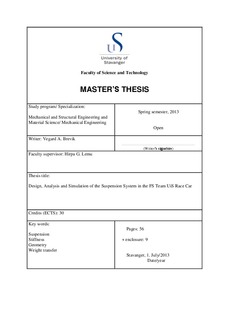| dc.contributor.author | Brevik, Vegard | |
| dc.date.accessioned | 2013-09-30T11:33:06Z | |
| dc.date.available | 2013-09-30T11:33:06Z | |
| dc.date.issued | 2013 | |
| dc.identifier.uri | http://hdl.handle.net/11250/183058 | |
| dc.description | Master's thesis in Structural engineering | no_NO |
| dc.description.abstract | This master thesis concerns the design and analysis of the suspension for the Formula Student Team UiS racing car for the Formula Student 2013 student competition.
To analyze how parameters such as track width, wheelbase, weight distribution, CoG height and total weight affected the overall performance a virtual racetrack was constructed. Calculations were then done to find the cars lap time as the various parameters were altered.
Results showed that reduced weight and CoG height and increased track width and wheelbase all improved the performance of the car. The analysis do not incorporate the necessary weight increase to increase track width and wheelbase, thus, further calculations are needed to determine the full effect of changing these parameters. Nevertheless the rear track was increased from 1188 mm to 1240 mm to improve cornering ability.
The analysis revealed an increase in performance with increased rearwards weight distribution as high as 70/30 rear/front. This weight distribution causes the cornering ability to deteriorate but gave sufficient improvement for acceleration and braking to reduce the total lap time. The car was still designed with a 50/50 weight distribution due to all the complicating effects of reduced cornering ability such as over/understeer but this is a recommended area for further analysis.
Bump stiffness was designed based on required ground clearance during maximum acceleration. Since the track width is smaller than the wheelbase the car is inherently softer during lateral acceleration as opposed to longitudinal (e.g. braking) but the use of ARBs effectively increased the lateral stiffness (i.e. roll stiffness) without too much increase in bump stiffness. The use of adjustable ARBs also allows the roll stiffness and the sprung weight transfer distribution to be adjusted.
The suspension geometry was designed to minimize scrub and jacking while having good camber gain and roll center height. The camber gain front and rear is 0.0369 °/mm and 0.0426 °/mm respectively corresponding to a camber loss fraction of 0.58 and 0.54 respectively. The roll center front and rear is 58.3 mm and 61 mm above the ground respectively. This height ensures that jacking and scrub are kept low while there is a large roll moment giving a large amount of sprung weight transfer which can be distributed between the front and rear track depending on chosen ARB stiffness’s. | no_NO |
| dc.language.iso | eng | no_NO |
| dc.publisher | University of Stavanger, Norway | no_NO |
| dc.relation.ispartofseries | Masteroppgave/UIS-TN-IKM/2013; | |
| dc.subject | materialteknologi | no_NO |
| dc.subject | byggkonstruksjoner | no_NO |
| dc.subject | suspension | no_NO |
| dc.subject | stiffness | no_NO |
| dc.subject | geometry | no_NO |
| dc.subject | weight transfer | no_NO |
| dc.title | Design, analysis and simulation of the suspension system in the FS team UiS race car | no_NO |
| dc.type | Master thesis | no_NO |
| dc.subject.nsi | VDP::Technology: 500::Mechanical engineering: 570 | no_NO |
| dc.source.pagenumber | 65 | no_NO |
